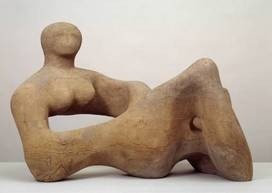Henry Moore
dal 23/2/2010 al 7/8/2010
Segnalato da
23/2/2010
Henry Moore
Tate Britain, London
Radical, experimental and avant-garde, Henry Moore was one of Britain's greatest artists. This stunning exhibition takes a fresh look at his work and legacy, presenting over 150 stone sculptures, wood carvings, bronzes and drawings. Moore rebelled against his teachers' traditional views of sculpture, instead taking inspiration from non-Western works he saw in museums. This exhibition presents examples of the defining subjects of his work, such as the reclining figure, mother and child, abstract compositions and drawings of wartime London.

curated by Chris Stephens
Radical, experimental and avant garde, Henry Moore (1898-1986) was one of Britain’s greatest artists. This major exhibition will re-assert his position at the forefront of progressive twentieth-century sculpture, bringing together the most comprehensive selection of his works for a generation. Henry Moore will present over 150 significant works including stone sculptures, wood carvings, bronzes and drawings.
Henry Moore will reveal the range and quality of Moore’s art in new ways – sometimes uncovering a dark and erotically charged dimension that challenges the familiar image of the artist and his work. Henry Moore first emerged as an artist in the wake of the First World War, in which he served on the Western Front. This exhibition will emphasise the impact on Moore’s work of its historical and intellectual contexts: the trauma of war, the advent of psychoanalysis and new ideas of sexuality, and the influence of primitive art and surrealism.
The exhibition will explore the defining subjects of Moore’s work, including the reclining figure, the iconic mother and child, abstract compositions and seminal drawings of London during the Blitz. The exhibition will assemble a group of Moore’s great reclining figures carved in Elm wood, the largest number ever to be brought together. These beautiful, heavily grained works show the development of the reclining figure over the course of Moore’s career. The recurring motif of the mother and child will be explored throughout the exhibition. Moore called it his ‘fundamental obsession’, and presented a complex vision of the maternal relationship, ranging from the nurturing bond of Mother and Child 1930-31 (Private Collection), to Suckling Child 1930 (Pallant House).
As Official War Artist, Moore made a series of drawings of Londoners sheltering in the London Underground from the Blitz. Henry Moore will include a selection of the most important of these, made between the autumn of 1940 and the summer of 1941. The drawings transformed Moore’s reputation, not only documenting, but helping to build, the popular perception of the Blitz. His depictions of rows of sleeping figures lying huddled in claustrophobic tunnels captured a sense of profound humanitarian anguish and the fragility of the human body. This continues in his work of the 1950s, reflecting the aftermath of war and the prospect of further conflict.
The exhibition will look at the influence of world cultures in his work, through his primitive masks and works such as Girl with Clasped Hands 1930 (The British Council). It will include abstract sculptures of the 1930s such as Composition 1931 (The Henry Moore Family Collection), threatening and sexualised works that suggest the influence of Freud and psychoanalytical theories such as Reclining Figure 1931 (Private Collection), and sculptures that capture the political tension and anxiety of the Spanish Civil War and the approach to the Second World War, such as The Helmet 1939-40 (The Henry Moore Foundation) and Three Points 1939-40 (Tate).
Henry Moore is a collaboration between Tate Britain and the Art Gallery of Ontario, Toronto. It is curated by Chris Stephens, Head of Displays at Tate Britain, and Michael Parke-Taylor, Associate Curator of European Art, Art Gallery of Ontario. It will be accompanied by a fully illustrated catalogue published by Tate Publishing.
Henry Moore was born in Castleford, Yorkshire. After serving in the First World War he studied at Leeds School of Art in 1919, and won a scholarship to the Royal College in London in 1921. He lived and worked in London and Kent, teaching at the Royal College and Chelsea School of Art. He won the International Sculpture Award at the 1948 Venice Biennale. From 1940 Moore lived at Perry Green, Much Hadham, in Hertfordshire, now home to the Henry Moore Foundation.
Image: Henry Moore, Recumbent Figure, 1938. Henry Moore, Recumbent Figure 1938. Tate © The Henry Moore Foundation.
Henry Moore: Curator's Talk
Thursday 11 March 2010, 13.00-14.00
Chris Stephens, curator of the Henry Moore exhibition, discusses Moore's work in the context of twentieth-century history. Situated in relation to the trauma of war, the advent of psychoanalysis, new ideas of sexuality, primitive art and Surrealism, this lecture provides a fresh look at one of Britain's best-loved artists.
Henry Moore supported by The Henry Moore Foundation. Sponsored by The British Land Company PLC, Finsbury and Goldman Sachs.
With additional support from the Tate Patrons and The Henry Moore Exhibition Supporters Group.
For further press information please contact Daisy Mallabar/Louise Butler/Duncan Holden
Call 020 7887 8731/8732/4939 Email pressoffice@tate.org.uk
Tate Britain
Millbank - London
Opening hours:
Tate Britain is open daily, 10.00-17.50
Exhibitions 10.00-17.40 (last admission 17.00)
Admission £12.50 ( £11 concessions)



